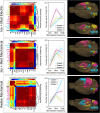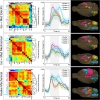Whisker pad stimulation with different frequencies reveals non-uniform modulation of functional MRI signal across sensory systems in awake rats
- PMID: 40698974
- PMCID: PMC12284883
- DOI: 10.1093/cercor/bhaf194
Whisker pad stimulation with different frequencies reveals non-uniform modulation of functional MRI signal across sensory systems in awake rats
Abstract
Primary sensory systems are traditionally considered separate units, but emerging evidence highlights notable interactions between them. Using a quiet and motion-tolerant zero-echo time functional magnetic resonance imaging technique, we examined brain-wide cross-sensory responses to whisker pad stimulation in awake and anesthetized rats. Our results indicate that whisker pad stimulation activated not only the whisker-mediated tactile system, but also auditory, visual, high-order, and cerebellar regions, demonstrating brain-wide cross-sensory and associative activity. Based on response characteristics, non-core regions responded to stimulation in a markedly different way compared to the primary sensory system, likely reflecting distinct encoding modes among primary sensory, cross-sensory, and integrative processing. Lastly, while low-order sensory activity was detectable under anesthesia, high-order processing and the complex differences between primary, cross-sensory, and associative systems were evident only in the awake state. This study reveals novel aspects of the cross-sensory interplay of the whisker-mediated tactile system and underscores the challenges of observing these phenomena in anesthetized rats.
Keywords: awake; functional magnetic resonance imaging; rat; stimulation; zero echo time.
© The Author(s) 2025. Published by Oxford University Press.
Figures






Update of
-
Whisker stimulation with different frequencies reveals non-uniform modulation of functional magnetic resonance imaging signal across sensory systems in awake rats.bioRxiv [Preprint]. 2024 Nov 14:2024.11.13.623361. doi: 10.1101/2024.11.13.623361. bioRxiv. 2024. Update in: Cereb Cortex. 2025 Jul 1;35(7):bhaf194. doi: 10.1093/cercor/bhaf194. PMID: 39605361 Free PMC article. Updated. Preprint.
Similar articles
-
Whisker stimulation with different frequencies reveals non-uniform modulation of functional magnetic resonance imaging signal across sensory systems in awake rats.bioRxiv [Preprint]. 2024 Nov 14:2024.11.13.623361. doi: 10.1101/2024.11.13.623361. bioRxiv. 2024. Update in: Cereb Cortex. 2025 Jul 1;35(7):bhaf194. doi: 10.1093/cercor/bhaf194. PMID: 39605361 Free PMC article. Updated. Preprint.
-
Short-Term Memory Impairment.2024 Jun 8. In: StatPearls [Internet]. Treasure Island (FL): StatPearls Publishing; 2025 Jan–. 2024 Jun 8. In: StatPearls [Internet]. Treasure Island (FL): StatPearls Publishing; 2025 Jan–. PMID: 31424720 Free Books & Documents.
-
Whole-brain responses to visual and auditory stimuli in anesthetized and minimally restrained awake mice using quiet zero echo time fMRI.Imaging Neurosci (Camb). 2024 Dec 5;2:imag-2-00384. doi: 10.1162/imag_a_00384. eCollection 2024. Imaging Neurosci (Camb). 2024. PMID: 40800373 Free PMC article.
-
Magnetic resonance perfusion for differentiating low-grade from high-grade gliomas at first presentation.Cochrane Database Syst Rev. 2018 Jan 22;1(1):CD011551. doi: 10.1002/14651858.CD011551.pub2. Cochrane Database Syst Rev. 2018. PMID: 29357120 Free PMC article.
-
Interventions for preventing neuropathy caused by cisplatin and related compounds.Cochrane Database Syst Rev. 2014 Mar 31;2014(3):CD005228. doi: 10.1002/14651858.CD005228.pub4. Cochrane Database Syst Rev. 2014. PMID: 24687190 Free PMC article.
References
MeSH terms
Grants and funding
LinkOut - more resources
Full Text Sources

